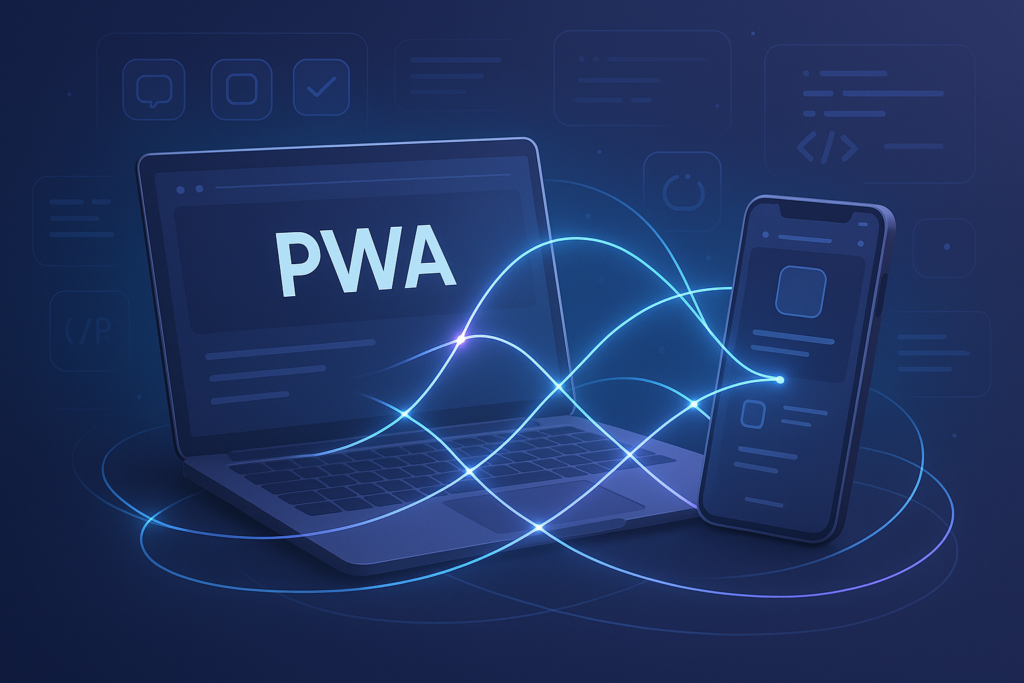Introduction
The modern web isn’t just about browsing anymore, it’s about experiencing. Fast loading times, smooth interactions, and offline access are no longer nice-to-have features; they’re expectations. That’s where PWA Progressive Web Apps come in, the secret sauce transforming how users engage with websites.
Whether you’re checking out your favorite eCommerce store or reading articles on the go, Progressive Web Apps make it all feel seamless, just like using a native app. In this post, we’ll break down what PWAs are, why they matter, and how they’re quietly shaping the future of web development.
What is a PWA (Progressive Web Apps)?
A PWA Progressive Web App is a type of web application that combines the best of both worlds, the reach of the web and the performance of native apps. Built using standard web technologies like HTML, CSS, and JavaScript, PWAs can be installed on your device and function offline, without needing to visit the app store.
Think of a Progressive Web App as a website that behaves like a mobile app, fast, reliable, and engaging, even with poor internet connectivity.
Key Features of PWAs
- Offline Access
Thanks to service workers, PWAs cache content so users can still browse even without an internet connection. - App-Like Experience
PWAs run in fullscreen, load fast, and support gestures, making them feel just like native mobile apps. - Push Notifications
Just like native apps, PWAs can send timely updates and notifications to keep users engaged. - Installable on Devices
Users can add a PWA Progressive Web App directly to their home screen, no app store required. - Automatic Updates
PWAs update automatically in the background, ensuring users always experience the latest version.
Why Businesses Are Adopting Progressive Web Apps
Companies like Twitter, Starbucks, and Pinterest have already embraced PWAs, and the results speak for themselves.
- Twitter Lite reduced data usage by 70% and increased engagement.
- Starbucks PWA doubled daily active users.
- Pinterest saw a 60% rise in core engagements after launching its PWA.
For businesses, this means faster user experiences, improved conversions, and broader reach, especially in regions with slow or unreliable internet.
Benefits of PWA Progressive Web Apps for Developers
- Single Codebase
Developers can build one PWA that works across all platforms, desktop, Android, and iOS. - Faster Development and Deployment
No need for separate native and web versions, saving time and cost. - SEO Friendly
Unlike native apps, PWAs are indexable by search engines, making them a dream come true for SEO. - Better User Retention
With faster performance and offline support, users are more likely to return and engage.
Examples of Successful Progressive Web Apps
Here are some real-world examples of Progressive Web Apps making an impact:
- Uber PWA – Loads in under 3 seconds on 2G networks.
- Spotify PWA – Lets users listen and manage playlists even offline.
- Flipkart Lite – Increased re-engagement by 40%.
- Trivago PWA – Boosted engagement by 150%.
These examples show how PWA Progressive Web Apps can deliver incredible results across industries, from travel to eCommerce.
How to Get Started with PWAs
Building your own Progressive Web App is easier than you might think. You’ll need:
- A secure site served over HTTPS
- A web app manifest (defining name, icons, and theme)
- A service worker to manage caching and offline access
Once you set these up, your site can behave just like a native app, installable, offline-ready, and fast.
The Future of Progressive Web Apps
In 2025 and beyond, PWAs are set to become the standard for modern web experiences. With major browsers and operating systems providing better support, Progressive Web Apps will play a huge role in how users access digital content.
As businesses strive to provide fast, reliable, and app-like experiences without the cost of native app development, PWAs stand out as the perfect solution.
Conclusion
The PWA Progressive Web App is more than just a buzzword, it’s the future of the web. By combining performance, accessibility, and user engagement, Progressive Web Apps empower developers and businesses to build experiences that truly matter.
If you haven’t started exploring PWAs yet, now is the time. The next era of the web isn’t about choosing between a website and an app, it’s about having both in one.
